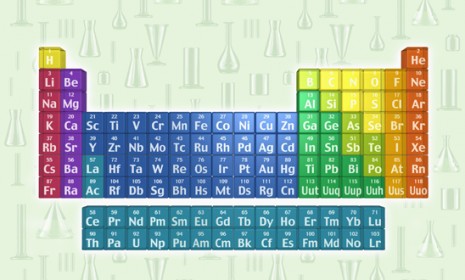Play all audios:
Two new elements are joining old chemistry-class favorites on the periodic table. The latest inductees — number 114, flerovium (Fl), and number 116, livermorium (Lv) — were revealed by the
International Union of Pure and Applied Chemistry and are now open for public discussion. Here, a brief guide to the new submissions: WHAT ARE THEY, EXACTLY? Numbers 114 and 116 will sit
"down in the lower-right corner of the periodic table." In real life, both elements are "so large and unstable" that they can only be created in a lab, says Jennifer
Welsh at _Live Science_. Known as "super heavy" or "Transuranium" elements, "they fall apart into other elements very quickly," so scientists haven't been
able to study their potential applications quite yet. The elements were first synthesized over 10 years ago, but it was only recently — and through repeated experiments — that their
existence was finally confirmed. Number 115 is still awaiting validation. SUBSCRIBE TO THE WEEK Escape your echo chamber. Get the facts behind the news, plus analysis from multiple
perspectives. SUBSCRIBE & SAVE SIGN UP FOR THE WEEK'S FREE NEWSLETTERS From our morning news briefing to a weekly Good News Newsletter, get the best of The Week delivered directly
to your inbox. From our morning news briefing to a weekly Good News Newsletter, get the best of The Week delivered directly to your inbox. HOW DID THE NEW ELEMENTS GET THEIR NAMES? Naming an
element is an "arduous" process, says Kenneth Chang at _The New York Times_. The current names are merely proposals put forth by the International Union of Pure and Applied
Chemistry, "the scientific body that is the keeper of the list of elements." The union has "finicky rules about what it considers an acceptable name." For instance, if a
previously proposed element's name is rejected, that name cannot be proposed for any "subsequent element discoveries." SO WHAT ABOUT FL AND LV? Livermorium was named after the
city of Livermore, Calif., where it was created. And Flerovium was named after Georgi N. Flerov, the founder of the Russian research institute where it was discovered. The public is invited
to discuss what to name both elements, so consider the current names "placeholders," says Alan Boyle at _MSNBC_. "The names still have to go through after a five-month public
comment period," and are set to be written into the table officially in May. "If you do not like them," says Chang, "now is the time to voice your objections." A
free daily email with the biggest news stories of the day – and the best features from TheWeek.com _SOURCES: Live Science, MSNBC, NY Times_

